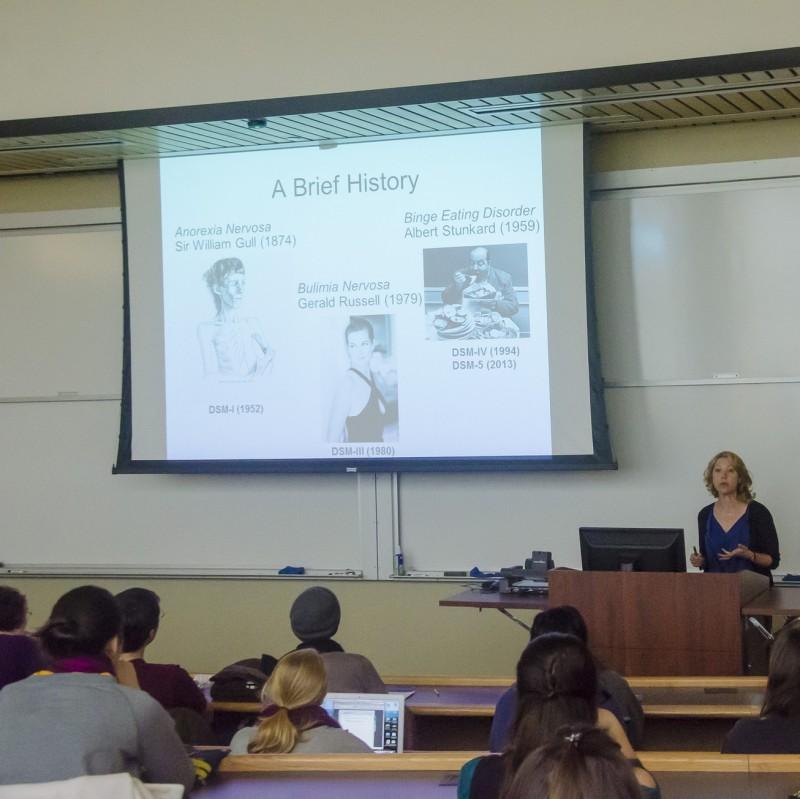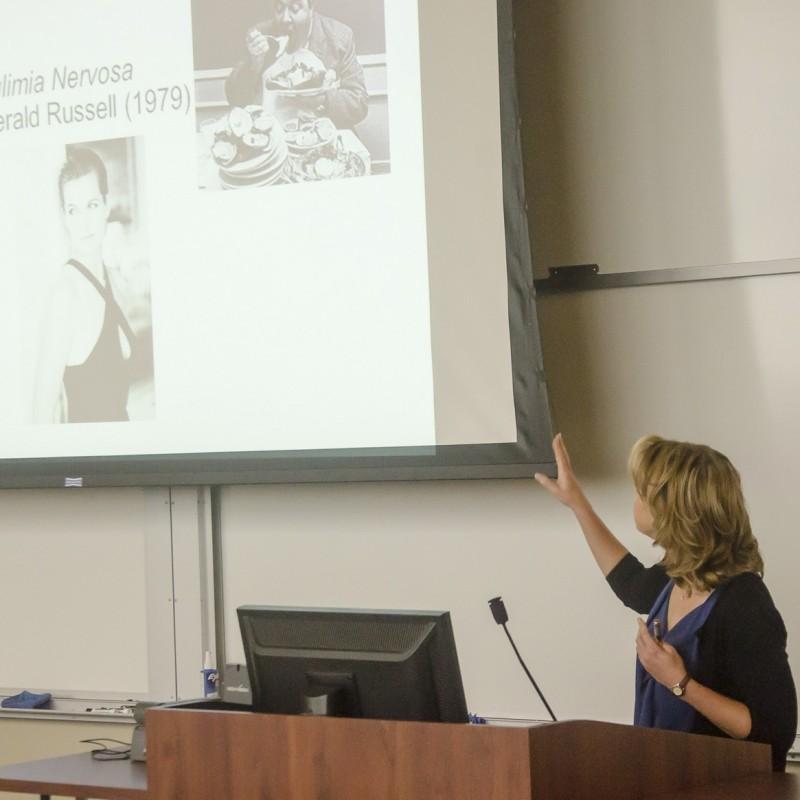Trinity neuroscience majors gathered together in the Center for the Sciences and Innovation on Nov. 14, 2014, to listen to Pamela Keel of Florida State University speak about the neurobiological evidence of a newly classified eating disorder.
Dr. Pamela Keel came to talk about the neurobiological evidence for an apparently new eating disorder. The disorder is called purging disorder, PD, is defined by Keel as “an eating disorder characterized by recurrent purging and most often, self-induced vomiting to influence weight and shape after eating normal or small amounts of food in individuals who are not underweight.”
This disorder differs from bulimia nervosa in the sense that individuals with P.D. eat the same amount of food as an average person and purge; most often by self-induced vomiting. People with bulimia nervosa binge-eat by consuming high quantities of food, almost double the average amount of a normal meal, and then purge.
Carolyn Becker, professor of psychology and the president-elect of the Academy of Eating Disorders, brought Keel to Trinity for the neuroscience lecture.
“She is the world’s leading expert in purging disorder, and really good at understanding eating disorder phenomenons from multiple perspectives, which I thought would be great for the neuroscience lecture,” Becker said. “She has a strong background in understanding eating disorders from a biological perspective, but also weaves that in with psychological and behavioral data. She also has a socio-cultural perspective.”
All those in attendance received extra credit for their neuroscience class. Among them was sophomore Ashley Ogilvie, who attended the lecture for her neuroscience class.
“The topic in general is just really interesting, it’s really relevant to society. So I was really excited to see it anyway,” said Ogilvie.
Keel described the populations most likely to suffer from purging disorder.
“[It]Purging disorder predominantly affects women; it is about ten times more common in women than it is in men,” Keel said. “You’ll see anorexia nervosa in younger adolescents like girls right around puberty. With bulimia nervosa a lot of times you’re seeing it right around 16 or 17 years old.”
Purging disorder, however, begins around the age of 20. According to Keel, Keel also notes that “Women with purging disorder do have significant concerns about their weight and shape and we know at a population level, that those weight and shape concerns are greatest in young adolescence and young adulthood.”
While many young adults with eating disorders like such as bulimia nervosa eventually stop and get help, there are some whose will have their disorders change and evolve.
“For some people, it will morph and change into anorexia nervosa, or it could change into… what used to be known as “˜eating disorder otherwise not specified,’ now known as OSFED, which is Other Specified Feeding and Eating Disorders. So it can change into anorexia nervosa, it can move into OSFED, it can come to an end or it could just continue,” said Becker.
Individuals with eating disorders are at a very high risk level for death.
“Eating disorders are associated with the highest risk of premature death, particularly from suicide but also from the medical complications of the illness,” Keel said. “And within the eating disorders that risk is particularly high for anorexia nervosa. It is said that one1 in 20 women with purging disorder are dead five years later.”
In a longitudinal study conducted in Germany, it was found that women with purging disorder had the highest retention rate of any other eating disorder. Despite this,Although it has the highest rate it is a fairly uncommon and therefore unknown eating disorder. Keel described it as a new disorder during The term “New” being used in the talk to explain that while it is slowly becoming better-more and more known, it is also not unlike other eating disorders, particularly bulimia nervosa.
While there is much stigma around eating disorders, the Academy of Eating Disorders AED (Academy of Eating Disorders) is extremely active.
Becker, the president elect of the academy, notes, “We have a phenomenal volunteer base that is very active in trying to reduce the stigma associated with eating disorders, inform best practices with eating disorders. We have a guide out that’s the medical care standards guide, a document that, for instance, patients can take to their physicians who may not know anything about eating disorders and be like “˜here’s medically what I might need.’ So the organization is a very active organization.”
“The topic in general is just really interesting, it’s really relevant to society. So I was really excited to see it anyway,” said Ogilvie.
Keel described the populations most likely to suffer from purging disorder.
“Purging…..disorder predominantly affects women; it is about 10 times more common in women than it is in men,” Keel said. “You’ll see anorexia nervosa in younger adolescents like girls right around puberty. With bulimia nervosa a lot of times you’re seeing it right around 16 or 17 years old.”
Purging disorder, however, begins around the age of 20. Keel also notes that “Women with purging disorder do have significant concerns about their weight and shape and we know at a population level, that those weight and shape concerns are greatest in young adolescence and young adulthood.”
While many young adults with eating disorders like such as bulimia nervosa eventually stop and get help, there are some whose disorders change and evolve.
“For some people, it will morph and change into anorexia nervosa, or it could change into… what used to be known as “˜eating disorder otherwise not specified,’ now known as OSFED, which is Other Specified Feeding and Eating Disorders. So it can change into anorexia nervosa, it can move into OSFED, it can come to an end or it could just continue,” Becker said.
Individuals with eating disorders are at a very high-risk level for death.
“Eating disorders are associated with the highest risk of premature death, particularly from suicide but also from the medical complications of the illness,” Keel said. “And within the eating disorders, that risk is particularly high for anorexia nervosa. It is said that one in 20 women with purging disorder are dead five years later.”
In a longitudinal study conducted in Germany, it was found that women with purging disorder had the highest retention rate of any other eating disorder. Despite this, it is a fairly uncommon and therefore unknown eating disorder. Keel described it as a new disorder. The term “new” was being used in the talk to explain that, while it is slowly becoming better-more and more known, it is also not unlike other eating disorders, particularly bulimia nervosa.
While there are stigmas around eating disorders, the Academy of Eating Disorders AED is extremely active.
“We have a phenomenal volunteer base that is very active in trying to reduce the stigma associated with eating disorders, inform best practices with eating disorders,” Becker said.
Becker also noted the use of a standard guide that helps keep the organization involved.
“We have a guide out that’s the medical care standards guide, a document that, for instance, patients can take to their physicians who may not know anything about eating disorders and be like here’s medically what I might need.’ So the organization is a very active organization,” Becker said.








